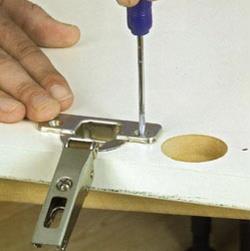Tuesday, November 6, 2012
Concealed hinges are standard fittings for most kitchen cabinet or closet doors. Over time, a hinge plate can become loose due to wear and tear. If this happens, you can fix the hinge above or below its existing position.

Hinge plates can become loose or broken over time, but it is relatively easy to replace them.
To repair a broken or damaged hinge, unscrew the hinge plate and remove it.
Use a pencil and tape measure to mark off a new position, using the old position as a guide.
You can raise or lower where you want to place the hinge, depending on the space available.
Measure and mark off for the new position on the door, allowing enough space for the diameter of the new hole to be drilled.
Measure the diameter of the existing recess, so you will know exactly what size cutting bit to use.
Using a Forstner or MAD bit, drill out the recess for the new hinge.

Make an indent with a drawawl (shown) and then screw the hinge in place with 16mm screws, ensuring the hinge sits flush against the inside of the door.
Take care not to drill too deeply and to prevent this, stop occasionally to fit the hinge into the recess and check for drilling depth so you know when to stop.
Make an indent with a drawawl (shown) and then screw the hinge in place with 16mm screws.
Ensure that the hinge sits perfectly flush against the inside of the door.
Re-hang the door using the old plate hinge.
Use spackle or wood filler to fill in the old holes.
Let dry and sand smooth with 240-grit sandpaper.
DIY Tip: If you need to fill the old hinge recess, remove the door and place on a flat, level surface. Use No More Nails to fill the hole to 2mm below the surface and leave this to dry for 24-hours. Once dry, use wood filler or spackle to level and smooth. Any roughness can be sanded smooth once this final finish is dry.
Article courtesy of www.home-dzine.co.za

Home - Dzine
Your online source of ideas and inspiration.